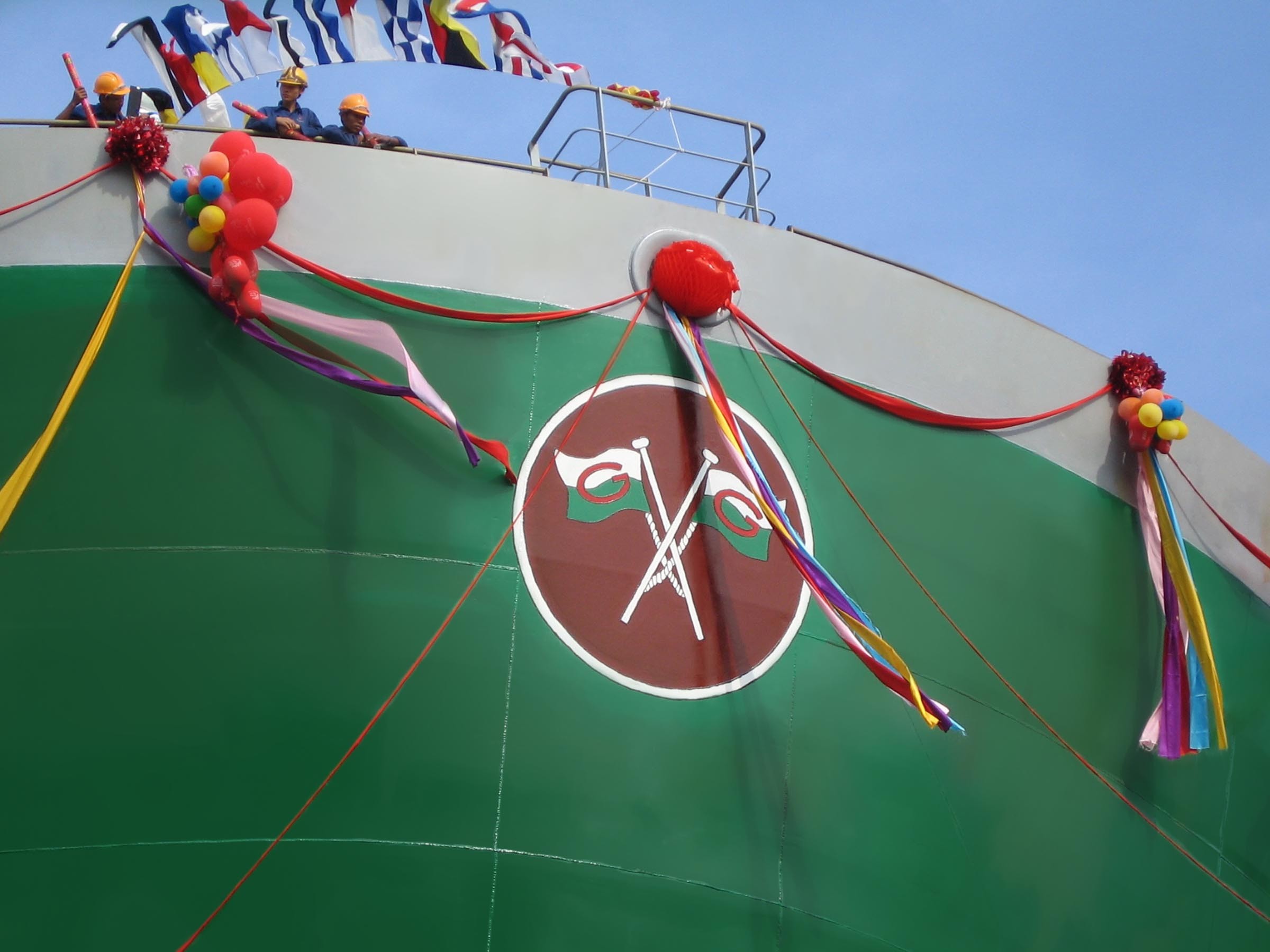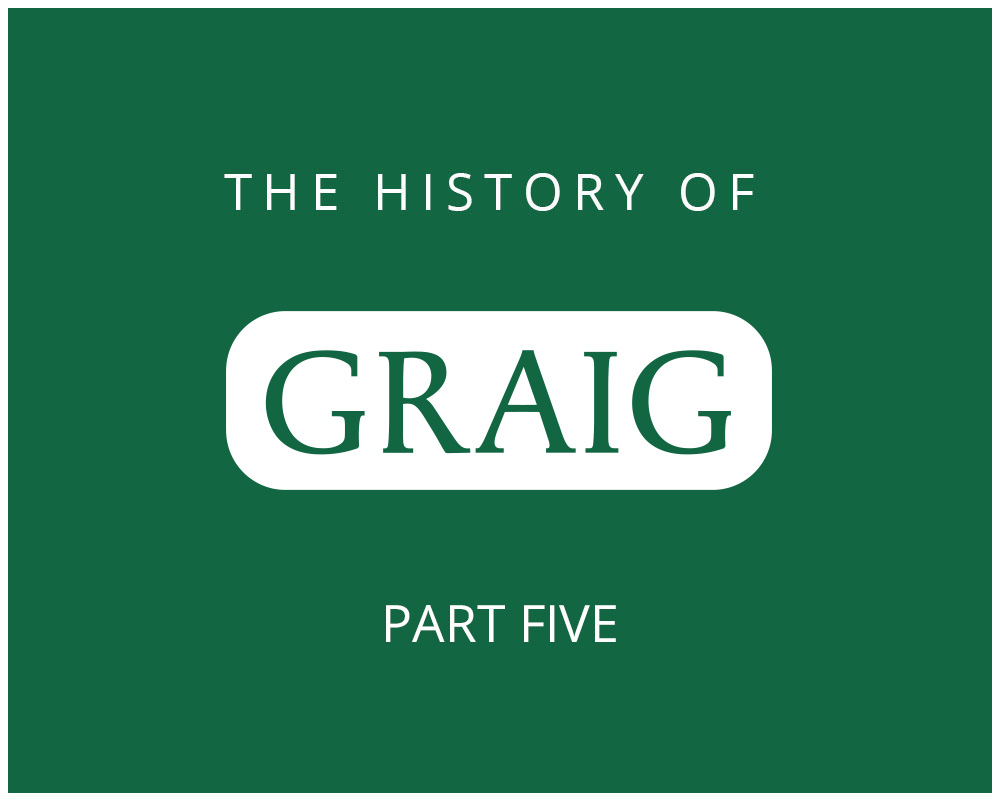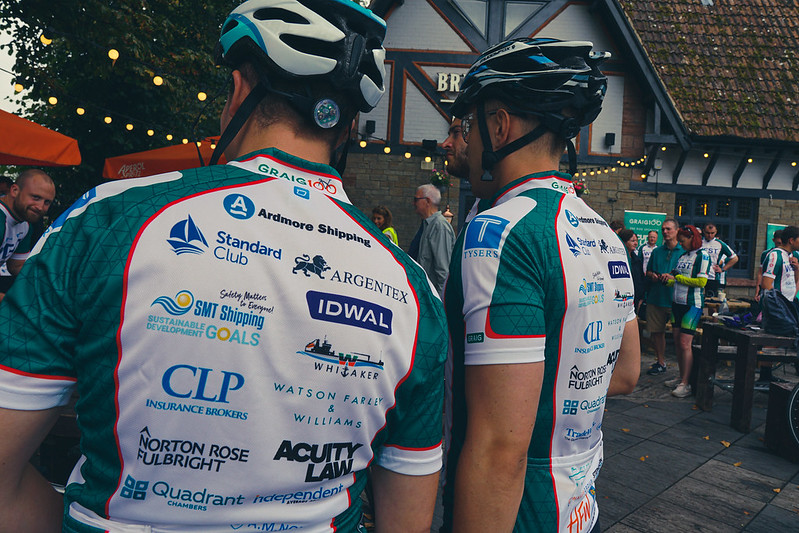Capesize and Coasters
Although freight rates remained depressed in the early 1980s, Graig bucked the trend somewhat with the sale of the Garthnewydd in 1981. Built in 1974 for $10.5m, she was sold that year to Portugese buyers for $18.5m! This left Graig with just one ship, the Graigwen, at a time when the freight market continued to be in dire straits, said by some to have been the worst slump in tramp shipping since the early 1930s. Nevertheless she proved to be a profitable and flexible vessel, with her ability to discharge her own cargoes quickly making her a sought-after vessel on the charter markets. Following the voyage to the Great Lakes referred to above, for instance, she was engaged upon a series of charters carrying cement clinker from Durban to Shuaiba in Kuwait, where she was able to discharge her entire cargo of some 28,000 tons in three days. The fact that the company now only had one ship, resulting in far fewer crewing commitments, led to the sale of Reigate Travel Ltd. in 1981. Some further diversification came in 1982 with the purchase of a 40% interest in Girovend Cashless Systems Ltd., which specialised in electronic vending systems and a similar interest in Edward J. Weston and Co. Ltd., a certification and consultancy company involved in the offshore oil and gas industries. The results in the various oil and gas drilling concessions unfortunately proved to be somewhat mixed. 1983 saw adjustments in Graig’s capital structure; in order that the company’s issued capital better reflected its increased assets, the nominal capital was increased from £500,000 to £2m with the creation of an additional 1.5m shares.
The sale of the Garthnewydd had left Graig with a large cash surplus, and the board gave considerable consideration as to how this sum should best be re-deployed. It came to their notice that there was an UK-built capesize (108,000dwt) bulk carrier, the Benwyvis, laid up at Southampton, which was offered for sale. She had been built as Alnwick Castle by Swan Hunter Ltd. in 1974 for W.A. Souter and Co. Ltd. of Newcastle and immediately placed on a time charter carrying coal for the Australian Coastal Shipping Commission. Despite being nine years old she was in excellent overall condition; she was purchased in 1983, extensively re-fitted for $4.5m and given the name Graiglas (3). So the Garthnewydd had been replaced by a vessel of the same age, but twice her size and for a quarter of the price! The Graiglas had been built originally to trade at a speed of 15.5 knots burning ninety tons of oil per day, but with the price of bunkers quite high at the time, this was clearly uneconomic. After some experimentation at sea, Graig’s technical team came up with an optimum operational speed of nine knots burning sixteen tons of fuel per day; as she would be engaged exclusively upon the transport of low-value, high-bulk cargoes under Graig’s management, speed was not essential and she was thus able to show a profit despite the low freight rates that prevailed into the 1980s. An opportunity arose later that year to acquire a similar, if slightly older, vessel, the 108,000dwt Energy Pioneer, owned by a Singapore-based company. Built by Harland & Wolff in Belfast in 1968 as Skaufast, she too underwent an extensive $6m refit at Rotterdam and was placed in the ownership of Garth Shipping as the Graigffion (2). The Graigwen was sold in November 1983 to help finance these purchases.
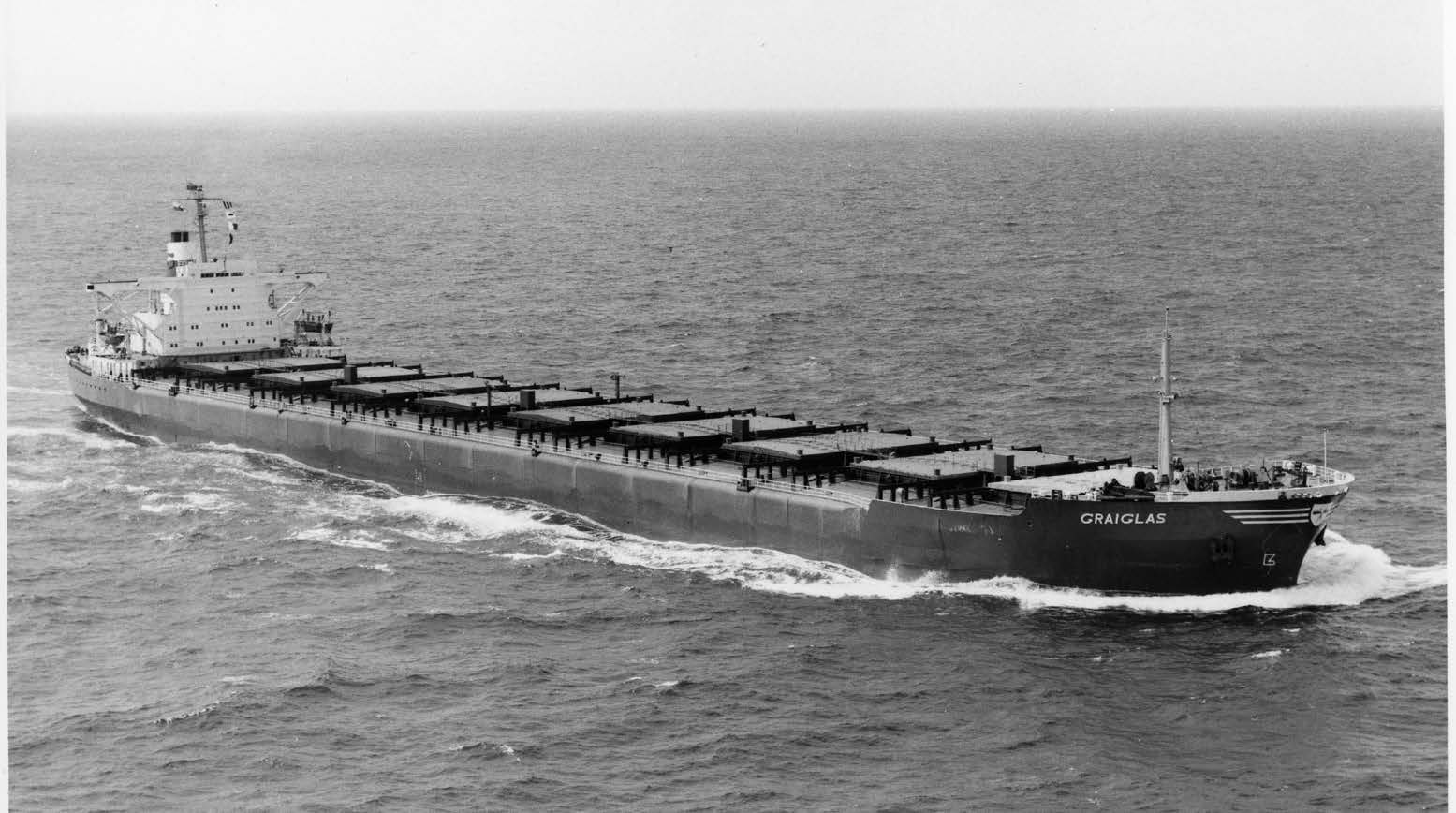
Graiglas (3) the former Alnwick Castle. [Fotoflite incorporating Skyfotos]
The trades of these capesize vessels were very different from those of the smaller bulk carriers operated by Graig hitherto, consisting almost entirely of cargoes of coal or iron ore, and usually with long return ballast passages. Typical fixtures would be with coal from Hampton Roads in Virginia to Dunkirk for French power generators, iron ore from Monrovia in Liberia to Rotterdam for the German steelmakers Krupp and Thyssen and iron ore from Tubarao or Sepetiba Bay in Brazil to Kaohsiung, Taiwan. Of particular note were two visits made by the Graiglas to Port Talbot in the summer of 1991 with cargoes of iron ore from Brazil for British Steel; these were the largest cargoes ever discharged in Wales by a Welsh-owned vessel. The Graiglas would remain with Graig for ten years, but the Graigffion was sold in 1985 to Bahamian buyers. During the following year the buyers defaulted on their payments and the vessel, under her subsequent name of Nassau Pride, was bought back by Graig and eventually sold again to other Bahamian interests in 1988.
1984 saw the retirement of Keith Gowen as company secretary, though he remained on the board as a director. His place as company secretary was taken by Glyn Harris who had joined Graig as an office boy in 1967. It was also a year in which Graig Shipping embarked upon three very different shipping investments, none of which proved particularly successful. The first was the purchase of the 1966-built 7,975dwt collier Cymbeline from Hadley Shipping of London; renamed Green Rock, it was intended that her engine would be converted to burn heavy fuel oil and that she would then be placed on a five-year bareboat charter. She was the only Graig-owned vessel to carry a cargo of pumice for Maple Aggregates from Yali to Barry. However, the bareboat charter collapsed soon afterwards and the vessel was sold at a loss in 1986 after a period laid-up at Sunderland. July 1985 saw the delivery to the company of the smallest vessel ever to wear the Graig colours, the 1,334dwt motor coaster Gwyn, built by the Yorkshire Drydocks Co. Ltd. of Hull. As Graig had no experience of the coasting trades, she was placed under the commercial management of the well-known London coaster owners F.T. Everard and Sons, but her service with the company was to prove short lived. On 3 November 1985, her cargo of steel products, loaded at Hamburg for Seaham, shifted and she foundered without loss of life off the Dutch coast. Raised a year later, she was eventually converted for further use as a sand dredger. Finally, also in 1985, the Garth Shipping company acquired the 1974 Swedish-built products tanker Sofie, which was renamed OT Garth and immediately placed upon a four-year bareboat charter. Within two years however, this charter too collapsed and she was sold to Greek owners based in Piraeus. And in common with a number of other British shipowners at that time, Graig also ‘flagged-out’ in 1986, setting up a new subsidiary company Graig Bermuda Ltd, with Hamilton the new port of registry in place of Cardiff.
Graig’s interests in the oil industry underwent considerable changes at this time. Indifferent results from oil exploration on the various sites located in the south of England led to the sale of 75% of Graig Exploration Ltd. to Petrofina (UK) Ltd. in 1985, but at the same time a new company named Garth Resources Ltd. was established by Graig to oversee new exploration investments in north America, on sites in Ohio, Mississippi, Nebraska and Texas in the USA, and Alberta in Canada. To consolidate the company’s presence in the USA, an American company, Graig International Inc., was established at this time. There were also investments in new exploratory blocks in the UK, near Nottingham and on the north Yorkshire coast near Bridlington, in partnership with Shell UK. More diversification was embarked upon in 1986 with the acquisition of interests in London stockbrokers Greig, Middleton and Co. and Cardiff-based architects Hoggett, Lock-Necrews. A 50% interest was acquired at the time in Maple Aggregates (whose chartering business Graig had been handling since 1975), whilst closer to the core shipping business, Graig took a 60% interest in the newly-established international bunker brokers North End Oil Ltd. from 1 January 1987. Early 1988 also saw further changes to the board when T.B. Hamilton left Graig, to be replaced by David Ellis who had been with the company since 1970; he would serve as a director until his retirement in 2007.
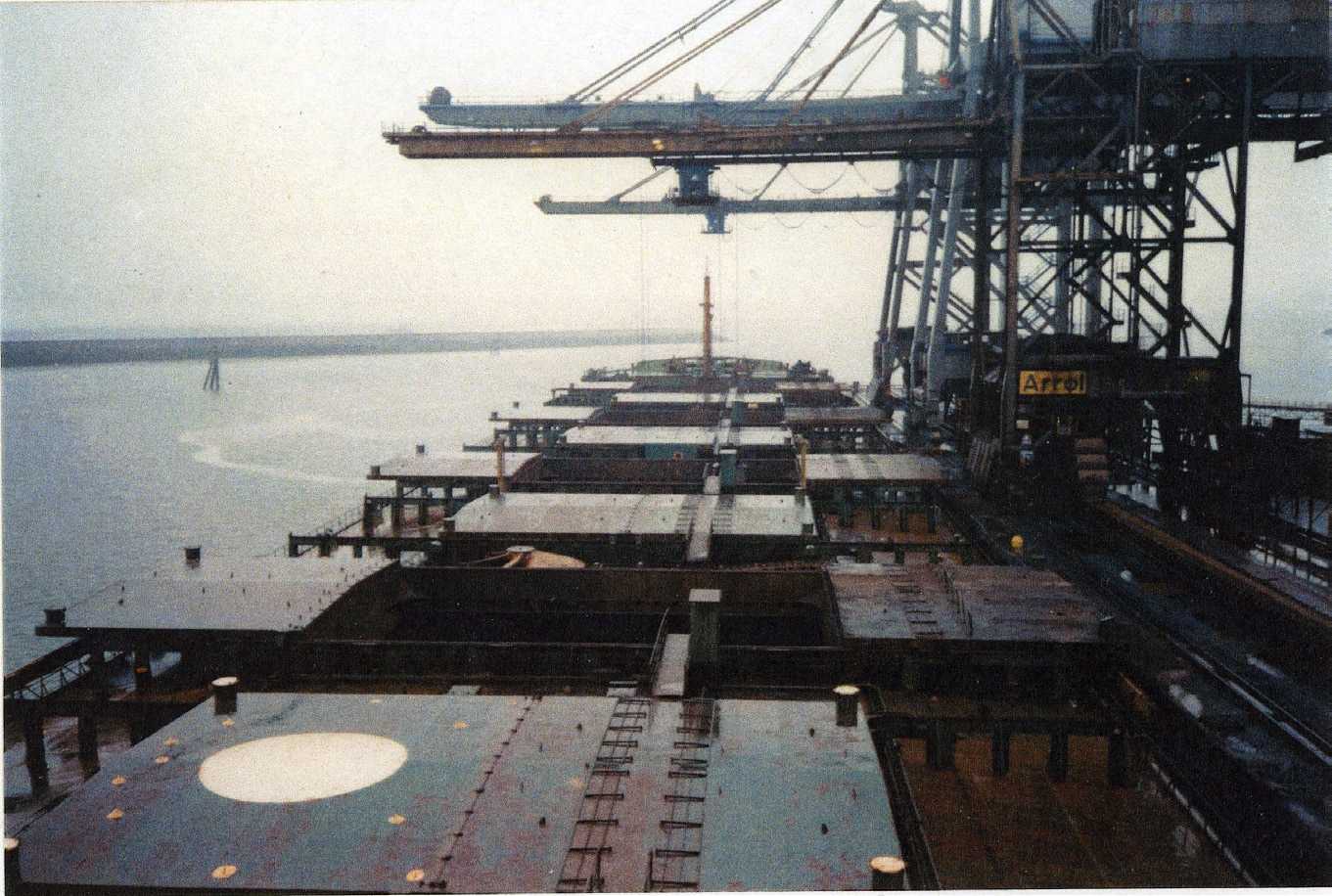
Graiglas discharges Brazilian iron ore at Port Talbot in 1991.
With the freight market rising steadily throughout the late 1980s Graig Shipping took the opportunity in 1987 to purchase a geared bulk carrier of 38,095dwt, built at Varna, Bulgaria in 1982 as Vari for Syros-based Greek shipowners; upon acquisition she was re-named Graigwerdd (2). Shortly afterwards a chance meeting at Epsom racecourse between Peter Tudball and representatives of the same Varna shipbuilders - the Georgi Dimitrov Shipyard - led to an agreement to build a slightly larger sister vessel of 40,315dwt at a cost of £6.4m; delivered in 1989 she was named Garth. Such was the buoyant state of the freight market at that time that Graig made a record trading profit of £2,179,000 during the year ending 31 March, 1989, and this was surpassed the following year by a trading profit of £3,400,000. The continuing high freight rates led to a decision in 1990 to invest a substantial sum on a four-month refurbishment of the Graiglas, by then seventeen years old, to enable her to pass her fourth classification survey, whilst the Graigwerdd too underwent dry-docking for repairs. The following year, an offer for the Garth from Piraeus-based Greek shipowners which was over £3m in excess of her purchase price, was accepted, showing that the company - like any good tramp shipowner - was still willing to treat its vessels as commodities when the opportunity arose.
Graig took a symbolic step back to the 1920s in 1991 when it took a 50% interest in Europe Energy Group plc (previously Moray-Firth Exploration plc); amongst other assets, this company owned three private mines in the anthracite coalfield, though unlike the Newbrook colliery, these were further west in the Ammanford area. Further investments were made in the development of these mines, including the New Waunhir mine, over the following years.
In April 1992 Graig Shipping suffered a disaster comparable with that which befell it in 1946 when Merthyr House went on fire. On the night of 10 April the IRA left a massive truck bomb outside the Baltic Exchange, the shipping exchange in St Mary Axe in the City of London, mistakenly believing it to be the Stock Exchange. Graig’s London office at that time was in the adjacent Baltic Exchange Chambers, which, along with the Exchange was seriously damaged in the ensuing explosion; three people were killed. Graig’s managing director, Peter Tudball, had been appointed chairman of the Baltic Exchange the previous year, and he showed remarkable leadership at that time which saw the Exchange up and running again within three days in a temporary space at Lloyd’s of London. Graig’s London office was eventually re-located to Gracechurch Street after a short period in the offices of North End Oil in Baker Street.
